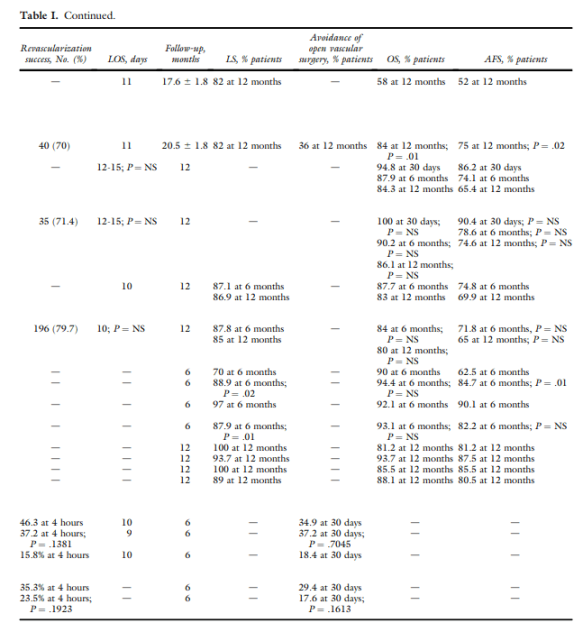One discussion this week involved open surgical versus endovascular revascularization for acute limb ischemia (ALI).
Reference: Wang JC, Kim AH, Kashyap VS. Open surgical or endovascular revascularization for acute limb ischemia. Journal of Vascular Surgery. 2016 Jan;63(1):270-278. doi:10/1016/j.jvs.2015.09.055.
Summary: Peripheral arterial disease affects approximately 10 million Americans. It can lead to lower extremity ischemic rest pain or tissue loss (Rutherford classification 4 to 6, or Fontaine classification III and IV). Acute limb ischemia (ALI) is defined as the presence of symptoms within 2 weeks of onset. ALI pathogenesis includes vascular stenoses with subsequent in situ thrombosis or thromboembolism from a cardiac or aortoiliac source. Stenotic lesions may indicate untreated comorbidities (eg, hypertension, hypercholesterolemia, diabetes, or tobacco use), whereas thromboembolisms implicate undiagnosed cardiac arrhythmias, myocardial infarction (MI), or mural thrombus. Limb loss risk due to ALI can be as high as 40% with an attendant mortality rate of 15% to 20% (p.270).
Limb salvage (LS) revascularization is traditionally achieved with emergent surgical thromboembolectomy or bypass. Catheter-based technologic advancements have afforded a wide array of endovascular therapy (ET) amenable for treating ALI, including catheter-directed thrombolysis (CDT), pharmacomechanical thrombolysis (PMT), angioplasty, and stenting.
For this review, a systematic literature review using MEDLINE (1990-2014) was performed with querying keywords acute limb ischemia, acute occlusion, peripheral arteries, thrombectomy, thrombolysis, and complications. Clinical trials, registry reports, open vs endovascular arterial revascularization, and review articles were included. Attention was given to revascularization techniques, short- and long-term patency, LS rates, amputation-free survival (AFS), overall survival (OS), and complications. Four RCTs and 5 other study types were analyzed.


CONCLUSION: ALI remains a morbid condition with high risk for limb loss and death. Based on the current evidence, ET is effective for LS and safer in the short term than urgent open revascularization in the studied patients. Still, individual patient factors need to be carefully considered for further generalization. ET and surgery are complementary rather than competing strategies for treating ALI. Further good-quality clinical trial data are required to define longer term outcomes.

Pingback: Bypass versus Angioplasty in Severe Ischaemia of the Leg | Surgical Focus